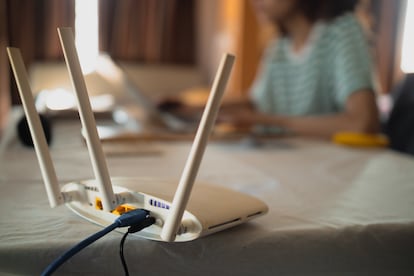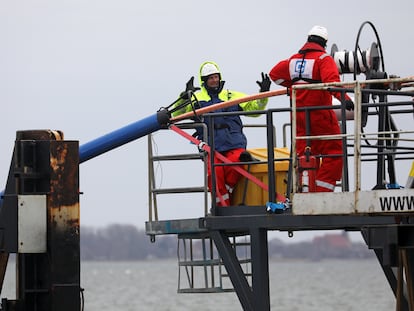Home Wi-Fi struggles with overload from more connected devices and data traffic
Tech companies are in a price war to offer the next generation of wireless internet


An airport that experiences exponential traffic growth but neglects to upgrade its control tower is doomed to face congestion, delays, and a decrease in flights. A similar situation occurs with home internet. Nowadays, most households have over a dozen devices connected to their Wi-Fi, demanding higher capacity and faster speeds for tasks like streaming high-quality media, gaming and remote work. In response to this demand, many internet service providers offer connections of one gigabyte (GB) or more, which equates to download speeds of roughly one billion bytes per second. But older routers with Wi-Fi 5 technology struggle to handle the increase data traffic effectively, and Wi-Fi 6 has only reached 18% of homes. Qualcomm recently introduced its new 10G Fiber Gateway platform, which uses the still-uncertified Wi-Fi 7 technology and earlier generations of Wi-Fi 6 to significantly expand residential internet capacity.
According to Spain’s National Statistics Institute, 96.1% of the country’s homes have access to fixed (83%) and mobile broadband. The Dynamic Spectrum Alliance (DSA) reports that only 13.1% rely solely on mobile connections, which is lower than some countries by over three percentage points. These numbers highlight the importance of updating residential routers to align with the new reality of internet use.
Chris Szymanski, director of product marketing at Broadcom, believes that transitioning to new generations of wireless interconnection is crucial. “Wi-Fi and cellular networks need to keep pace with each other because consumers expect their applications to work on whatever network they are connected to,” he told RCR Wireless News. “If people are mostly indoors, Wi-Fi capacity needs to be the primary focus for wireless broadband to drive new applications that operate indoors.”
Diego Huertas, global wireless architect at Ikusi, said, “Existing Wi-Fi networks lack the capacity to handle the increasing demand for connections and applications. Upgrading to the latest generations is essential to prevent common congestion issues and user complaints.”
According to Wi-Fi NOW CEO Claus Hetting, “This year, there will be 19.5 billion devices with wireless connections in use around the world,” with an annual growth of 20%. This growth makes the transition towards Wi-Fi 6E (the next evolution of Wi-Fi 6 introduced four years ago) and 7 inevitable. The Wi-Fi Alliance, the certification body for this technology, has confirmed that approval for the seventh generation is underway.
Certain companies are taking proactive steps. Router manufacturers TP Link and Eero have already embraced Qualcomm’s Wi-Fi 7 compatible platform, and Intel is also jumping into this market. In the United States, the average price for a Wi-Fi 7 router is about $600, and these devices will soon be available in Europe.

The technology is there, but it’s up to the operators to provide it, the users to demand it, and individual country regulators to allocate the necessary broadband spectrum. Diego Huertas says, “Wi-Fi 7 brings new functionalities, including the use of the 6GHz band for faster transmission. This unlocks greater access speed and helps alleviate network congestion. However, in Spain, only half of the channels in this band are enabled, putting the country at a disadvantage in terms of capacity.”
Other countries are already moving forward. Gary Koerper of Charter Communications in the U.S. stated that they will offer the next generation Wi-Fi “as a standard” for all users. British mobile network provider EE (part of the BT group) has also moved forward in this direction. “Customers build their lives on connectivity,” said EE’s Danny Marshall.
According to Qualcomm VP Rahul Patel, the next Wi-FI generation is crucial due to the network congestion in public spaces and homes. Patel estimates that in five years, 59% of all homes will have over 20 connected devices using up to 10 GB of daily data.
A report by ABi Research, which cites a study by technology developer Adaptive Spectrum and Signal Alignment (ASSAI), also warns of the limited capacity of the most common Wi-Fi standards used in home networks. This study indicates that the prevalence of Wi-Fi 5 is leading to a decrease in service quality due to higher congestion, latency and signal interference. “Subpar performance could also chip away at customer confidence in the operator, potentially resulting in customer churn. Thus, broadband operators are under immense pressure to deliver advanced Wi-Fi services for their customers.”
Price wars
Managing the panorama is proving to be challenging as price wars restrict telecommunications companies’ capacity to invest in infrastructure, services, and equipment. “I don’t blame the operators because they may be unsure about how to monetize this. If this continues, they won’t be able to invest in new technology,” admits Qualcomm’s Ganesh Swaminathan. Companies are reluctant to invest in wireless technologies, but now is the perfect time to do so, says Ikusi’s Diego Huertas.
Swaminathan recognizes the need for a strategic shift and illustrates it with an example from Spain. “In countries like Spain, service providers can help by offering subscription tiers. Watching a high-definition movie with the best sound using Wi-Fi 5 is not enjoyable. Telefónica could simply declare, ‘That’s what you get for 33 euros.’ However, if Telefónica tells customers that for an extra five euros, they can have the best streaming experience available, then that has the power to change the existing model.”
Swaminathan also says customer demand is a key factor. “Regular highways funded by taxes are freely accessible to drivers. However, using an expressway entails a toll fee. Although it costs a few euros, it helps alleviate congestion on the toll-free road. The same concept applies to data transmission — congestion on the route from the cloud to the home may require toll roads for better service. Some may choose to not pay extra for these services, but others will. This will generate increased revenue from premium customers.”
Alex Roytblat of the Wi-Fi Alliance believes in the need to implement the highest internet speeds available to achieve Europe’s digitalization objectives, but says the current high inflation is a complicating factor. Customers may want additional capabilities but are hesitant to pay extra for faster connections and new equipment. Roytblat says 75% of respondents to an Eurobarometer survey conducted by the European Commission stated that a more affordable high-speed connection would greatly facilitate the use of digital technologies. “Based on these findings, it seems pretty clear that affordability will play a crucial role in whether Europe can actually achieve its digital goals.”
Sign up for our weekly newsletter to get more English-language news coverage from EL PAÍS USA Edition
Tu suscripción se está usando en otro dispositivo
¿Quieres añadir otro usuario a tu suscripción?
Si continúas leyendo en este dispositivo, no se podrá leer en el otro.
FlechaTu suscripción se está usando en otro dispositivo y solo puedes acceder a EL PAÍS desde un dispositivo a la vez.
Si quieres compartir tu cuenta, cambia tu suscripción a la modalidad Premium, así podrás añadir otro usuario. Cada uno accederá con su propia cuenta de email, lo que os permitirá personalizar vuestra experiencia en EL PAÍS.
¿Tienes una suscripción de empresa? Accede aquí para contratar más cuentas.
En el caso de no saber quién está usando tu cuenta, te recomendamos cambiar tu contraseña aquí.
Si decides continuar compartiendo tu cuenta, este mensaje se mostrará en tu dispositivo y en el de la otra persona que está usando tu cuenta de forma indefinida, afectando a tu experiencia de lectura. Puedes consultar aquí los términos y condiciones de la suscripción digital.










































